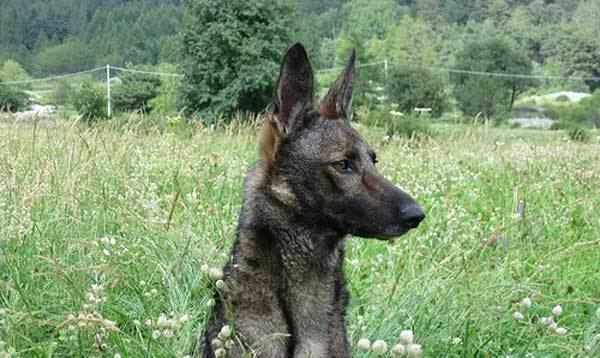Other names Italian Wolfdog Rank Hybrid | ||
 | ||
Scientific name Canis lupus familiaris x Canis lupus italicus Similar Rampur Greyhound, Kyi‑Leo, Sporting Lucas Terrier, Indian Spitz, Italian Shepherd | ||
The Lupo Italiano, also known as the Italian wolfdog, was a dog created by Mario Messi in 1966 by crossing a wolf from Northern Lazio raised as a puppy with a German Shepherd. Its maternal genetics and gestation was from the wild wolf.
Contents

Cane lupo italiano o chien loup italien
Characteristics

Unlike most wolf-dog hybrids this canine displayed a propensity to be used as a working dog, and its breeding was taken over by the Italian Government. A breeding facility was created in Cumiana (Piedmont) and the number of dogs gradually increased to about 700 specimens. The breed was officially recognized by the Italian Government and laws were passed to provide financial resources for its breeding. Nowadays numerous Alpine rescue teams utilize these dogs to search for avalanche victims. Over time, it has proven superior to the German shepherd in locating persons buried under snow. It has also been used as a rescue dog to locate persons trapped under the rubble of collapsed buildings in the aftermath of an earthquake. It has performed exceptionally well in this role.
Appearance

The Lupo Italiano's height ranges between 60 to 70 centimetres (24–28 in) for male, and 58 to 65 centimetres (23–26 in) for female. The head and its expression defines the sex of the animal. It has black lips and a strong jaw, with a full complement of 42 teeth: the bite is scissors-shaped. The body is sturdy, not too elongated. The abdomen is strong and tucked in. The spine is straight, and very well built. The rump is slightly lower set than the shoulders. The Lupo Italiano move quickly and gracefully, despite its size. Its trot should give the impression of "elegant force", reminiscent of the wild wolf. Its limbs are long, muscular, slightly angled. Its coat is of medium length and hardness, shorter and finer on the thighs, head and limbs. The Colour ranges from gray, with various markings, to cream, with a dark saddleback. The tail, without exaggeration, hangs low up to the hackles, and, like the Siberian husky, doesn't show any excessive curve.
Temperament

For the last 15 years the Italian State Forestry Corps have worked mainly with this dog, in Italy and abroad. The Lupo Italiano, when working with the forest patrol, is always competent and reliable. Its attitude to tasks such as avalanche and earthquake resque [sic] is formidable and it is extremely well suited for searching people or other animals lost in the mountains and woods. The Lupo Italiano was chosen to serve in Turin 2006 Olympic Games.
The Lupo Italiano is a loyal, fearless dog.
Use

The Lupo Italiano is well adapted for work in a mountain environment, as an avalanche dog and as a rescue dog. It is resistant to adverse atmospheric conditions and bad weather. It is not affected by snow-glare. With its keen sense of smell, it is ideally suited to search for missing people or wounded animals. It therefore proves to be an ideal aid for park rangers, or game wardens. It can also be trained as a police dog and possesses great physical strength and incredible agility. It can also be trained as a flock guard to protect livestock.

The breed is protected by presidential decreet stipulating that this 'State' dog can not be commercialized nor bred outside the officially recognized agency, the Etli, Ente Tutela del Lupo Italiano (Agency for the protection of the Lupo Italiano). For over 15 years the Italian State Forestry Corps has used this wolf-dog hybrid as their main working dog.
History
At the time of the breed's creation, nothing was known of the Czechoslovakian Wolfdog, even if it already existed, and the first Dutch attempt to create the wolf dog, the Saarloos Wolfdog, failed. In effect, the birth of Zorro, the first Lupo Italiano, was seen as a revolutionary victory.
Mario Messi, the breed's creator, dreamed of superior dogs managed by a specialized body working without profit. The goal was to provide animals for civil defense and the armed forces to save lives. An ambitious project, but especially expensive, which took the entire family fortune (extremely large), under the illusion that Italian politics would have supported and helped. He had some funding (already heavily criticized by his detractors), but an insufficient amount to sustain the costs of an enterprise too arduous. Someone sent him money thinking of helping the "real" Apennine wolf: then discovered that it was a different project and claimed that it was a scam.
The Italian wolfdogs have never been sold officially, because the moment of maximum interest for the breed would have been too complicated to try to entrust specimens and sell puppies. In other cases, animals that were passed off as Italian wolfdogs, were simply German Shepherd hybrids.
The original plan was for the dogs to be entrusted exclusively to people who used them for socially useful purposes. Messi counted on the help of the state in mind. In one example, Japan had even proclaimed "national treasures" his most important races: perhaps he was not quite clear on how things worked in the country.
